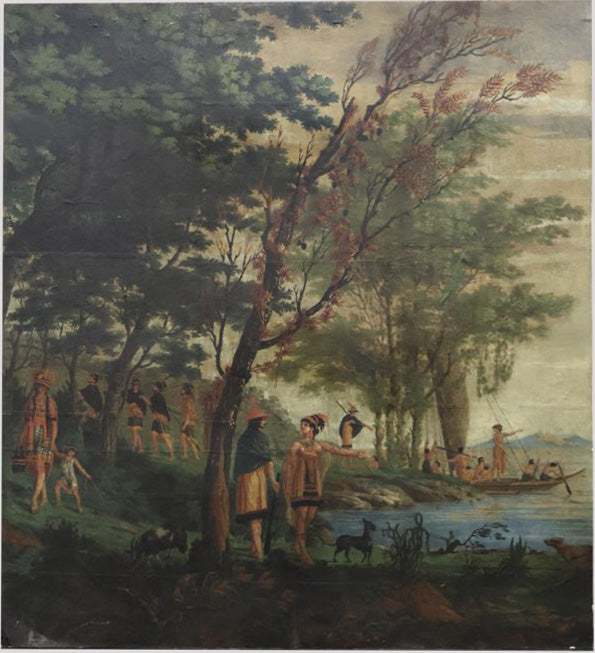from: A Monumental Pacific Panorama: Five Grand Decorative Panels After Cook’s Voyages
Joseph Dufour. New Zealand, Prince William Sound, and the Friendly Isles (Panels 11-13). 1804.
Joseph Dufour. New Zealand, Prince William Sound, and the Friendly Isles (Panels 11-13). 1804.
Couldn't load pickup availability
Joseph Dufour et Cie (est. 1797)
New Zealand, Prince William Sound, and the Friendly Isles (Panels 11-13)
From: *“Les Sauvages de la Mer Pacifique” or “Les Voyages du Capitaine Cook”*
Designed by Jean-Gabriel Charvet (1750–1829)
Mâcon and Paris, France: 1804–1805 Block-printed wallpaper
Dimensions: 69" x 62"
This panoramic scene from Les Sauvages de la Mer Pacifique brings together three distinct Indigenous cultures of the Pacific — each rendered with grace, movement, and dignity against a backdrop of towering trees and a coastal inlet. It is a powerful celebration of cultural complexity and first contact, offering a rare European attempt to portray Pacific peoples not as curiosities, but as sovereign and organized societies.
· At left, a Māori woman of Aotearoa (New Zealand) walks with her child along a forest path, accompanied by several warriors bearing weapons. Their garments — short flax cloaks dyed in olive and buff tones, along with facial tattoos and feather adornments — evoke the traditional dress and appearance recorded during Cook’s voyages. These figures, drawn from descriptions of Cook’s 1777 visit, embody the strength and familial bonds of Māori society. Dogs, domesticated and well-fed, appear alongside the group, reflecting their valued role in Māori daily life.
· Center, the focus shifts northward to Prince William Sound, Alaska, and the communities Cook encountered there in 1778. The central figure wears a striking cedar bark hat, emblematic of the Northwest Coast’s ceremonial dress, and visually echoes the style made famous by Nuu-chah-nulth leaders such as Chief Maquinna. Men and women nearby wear fur-lined robes, carry decorated tools, and adorn their faces with painted patterns. The detailing of clothing — including robes sewn from animal gut and accessories of shell and bone — reflects the craftsmanship and winter adaptation of these seafaring northern peoples.
· At right, a bustling shoreline captures the activity of the Tongan islanders of Nomuka (Annamooka). Figures carry oars and prepare their canoes — vessels adorned with outriggers and sails suited for oceanic travel. These navigators, praised by Cook for their refinement and hospitality, are portrayed mid-launch, with palm-lined shores behind them. Their minimal garments and poised movements reflect both elegance and communal purpose.
Historical and Cultural Context:
· New Zealand (Panel XI): This scene reflects a more domestic view of Māori life
— with women, children, and warriors coexisting in a shared landscape. It
underscores strength through kinship and everyday presence, moving beyond the conflict-driven depictions of earlier panels.
· Prince William Sound (Panel XII): Central to the composition, this portion presents the Indigenous peoples of the North Pacific coast with particular attention to ceremonial dress. The cedar bark hat and shell jewelry signify both status and cultural pride, while the robe and ornamentation reflect Cook’s detailed ethnographic notes from 1778.
· Friendly Isles (Panel XIII): The scene at far right captures the industriousness and navigational prowess of Tongan society. Their graceful canoes, efficient organization, and Cook’s recorded admiration reinforce Tonga’s place as a maritime powerhouse in the Pacific world.


